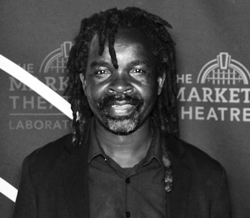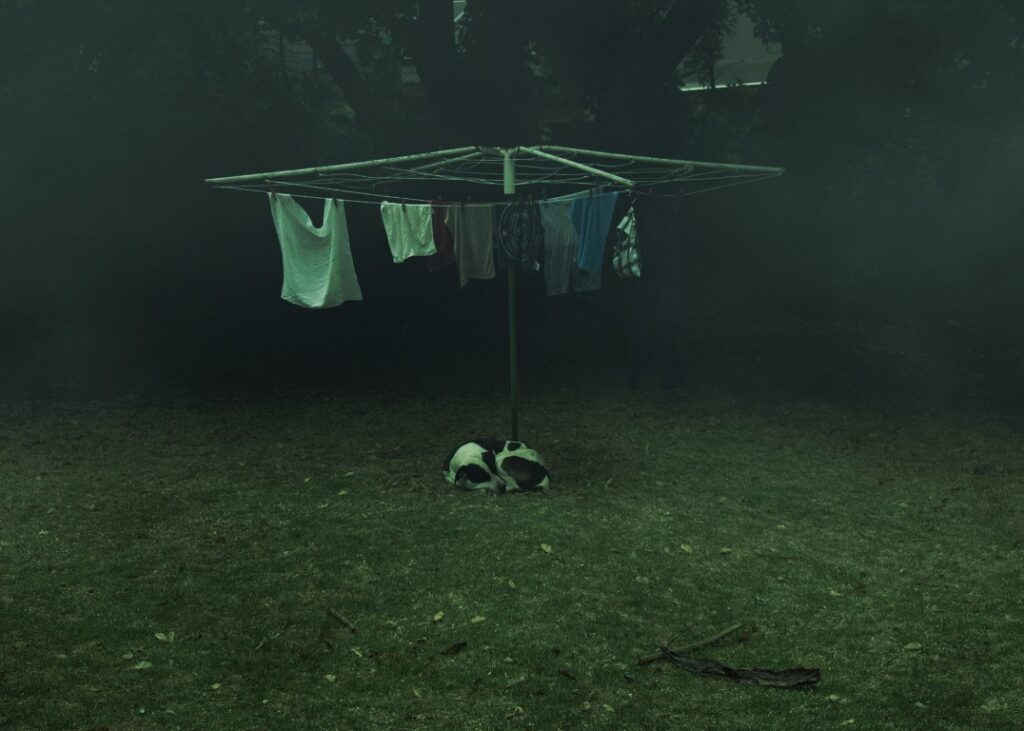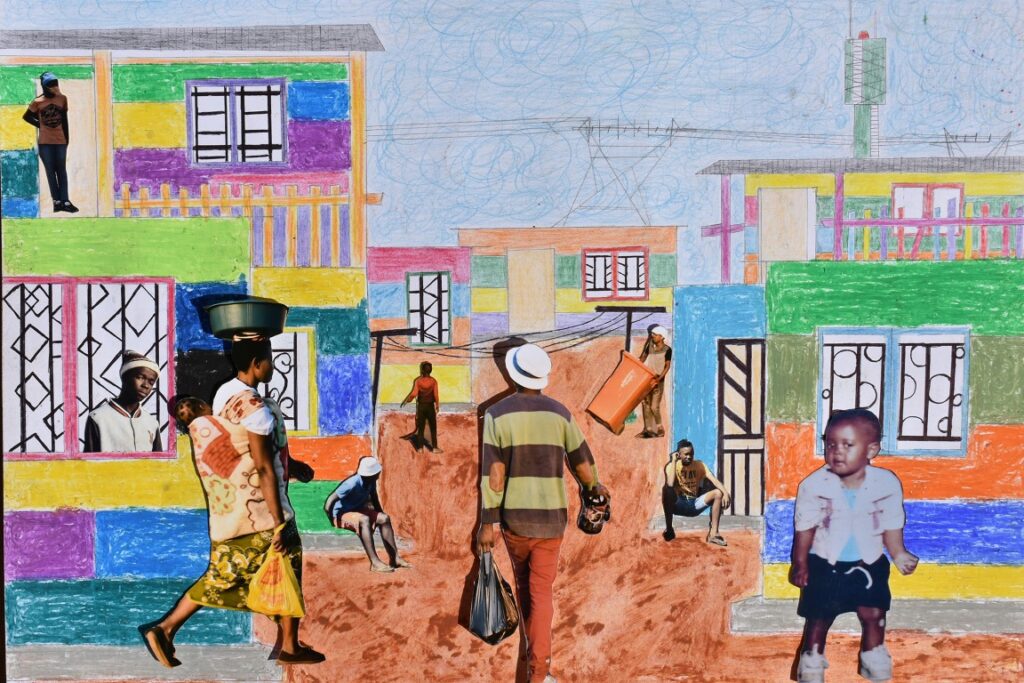The photographs on display beyond the façade of portraying a vibrant community and happy faces portray hidden truth about the township’s sins of the past
The exhibition at Constitution Hill I Put My Hand On My Chest To Feel My Heartbeat, carries a hidden message of a lingering painful past stilleating away at Thokoza township.
By Edward Tsumele, CITYLIFE/ARTS Editor

There is in this exhibition a number of portraits laid out next to each other. These are portraits of three elderly men who have been captured by the photographer in a relaxed mood. They seem to have been in their homes. What is stunning about these images is the fact that the elderly men seem to have surrendered themselves completely to the photographer, willing him to create whatever image he saw fit. The lighting has been used creatively, highlighting perfectly the areas where light needs to be amplified, such as the relaxed eyes of the people in the images, and where it needs to be dimmed. You can tell that the photographer took a lot of time with these people, making them relax, trusting him. Technically the photographer worked on his art, such as composition. This particular set of images seem to be a series, taken by one photographer. The texture is the same.
However, you cannot tell who these elderly men of Thokoza township are, who exude grace and their dignity seems not to have been invaded by the camera. By looking at these images, you will also not know who this young photographer is. This is no caption, and there is no credit to the photographer.
In fact, all the photographs I this exhibition are not captioned and the participating photographers’ names are missing next to their individual photographs. This is a curatorial mistake that should not have happened.
This is a pity because this exhibition is a powerful exploration and interpretation of life in Thokoza, a Johannesburg township on its eastern side. It is a township that like several others that the apartheid rule for years designated as settlements of black South Africans, strategically situated not near enough to the city, but not far enough to make it impossible for the working class to commute daily by either mini-bus taxis or the train provide labour to the mines and white areas. Thokoza is also a township that those that witnessed the transition from an apartheid South Africa to a democratic dispensation in 1994, will remember was torn apart by violence. The type that was described by journalists, sociologists and activists as black-on-black violence fueled and sponsored, it is said, by the then ruling National Party government which witnessed its grip on power slowly slipping away, drifting towards the hands of the then unbanned ANC led by Nelson Mandela, who had been released from jail in 1990, where he served 27 years. He Indeed became the first President of a democratic South Africa in 1994 after the watershed elections. The popular narrative is that the National party fueled and sponsored this violence in Thokoza and other East Rand townships such as Katlehong to weaken its opponent, portraying it as weak in the eyes of the voters in the 1994 democratic elections.

Therefore, this exhibition that is currently on at Constitution Hill in Johannesburg, which opened on Saturday February 1, 2025, featuring young visual voices, photographers of Thokoza is quite important. It tells the narrative of a township that emerged out of a very difficult history on the cusp of democracy to claim its place in a democratic South Africa. It is definitely a township that was scarred and its residents traumatized. But these images are recent creations. All the photographers participating in this exhibition did not witness what befell their parents and grand parents during that transition. They were not born.
This however does not mean that they are not aware of what happened in their township. That is why even though the images are not overtly political, or portray violence, beneath the facade of the old men captured in their graceful postures, women selling stuff on the narrow dusty pavements, young people dressed in a trendy fashion, faces of smiling mothers captured in their small gardens, smiling to the camera and a man pretending to be playing golf, with stones for gold balls, lies the painful message of a township that is still grappling with the past that damaged it physically, emotionally and threatened to destroy its soul. The sins of its past history still eating away at it, including its children that were not even born then, the so called Born-frees. This in reference to those born after apartheid had ended officially in 1984.
Though a viewer will not immediately get this message at first, after a while this does indeed emerge. After all that is what happens to trauma -it takes a long time to emerge and announce itself and it can be intergenerational.
That probably explains for example why in 2016, students’ anger at higher tertiary institutions of learning over the inability to pay university fees erupted into a wave of public protest that engulfed the country like never before. This is because they argued that their parents could not afford the fees, and that lack of affordability was very much linked to the complicated history of racial inequality their parents and grandparents were subjected to in apartheid South Africa. Their poverty was therefore intergenerational.
Therefore, the images in this exhibition, though at face value appear to be celebrating a good life in the post-apartheid South African township of Thokoza, a deeper reading of these images unearths a restrained anger over what could have been and was not in the township because of the sins of the past. That past is ever lingering in the present. Well hidden by the fashion that young people now don, the seemingly normal life that the residents live, ironically next to dirty, unpaved and rotting garbage that has not been collected for weeks. Therefore, as one navigates this exhibition, it is important to look for and discover what is hidden in this exhibition. For it is in the hidden that the uncomfortable past still lingers even as there is a pretence that it no longer exists. Truth is, it does, but has taken a different complexion. Making it hard to notice as the facade of happy faces and trendy fashion in Thokoza’s streets often deceives a naïve eye and a lazy mind.
Credit for this exhibition which aptly is celebrating 30 years of Democracy — and the residents of Thokoza township should indeed be granted to Of Soul & Joy. Of Soul & Joy (OSJ), is a pioneering educational programme dedicated to empowering youth in Thokozathrough photography.

Titled I Put My Hand On My Chest To Feel My Heartbeat it is hosted at Consttituon Hill from 1 February to 31 March 2025 and is inviting the public “to step into the vibrant community of Thokoza through the lens of its youth, offering arange of personal stories and visual narratives captured by some of South Africa’smost promising emerging photographers.:
Curated by Constitution Hill Creative Uprising Hub co-ordinator and multidisciplinary artist, LesoleTauatswala, the exhibition is a celebration of 30 yearsof democracy, showcasing intimate moments and displays of creativity that tell thestories of Thokoza and its residents. The photographs, taken by past and presentOSJ students, highlight the ordinary and extraordinary aspects of daily life, focusingon the youth of the township as they navigate their environment.
The works on display range from deeply personal explorations of family dynamics
and identity, to broader social themes such as belonging, and cultural symbolism.
The artists reflect on their unique relationships with their subjects, with many
examining the ways in which clothing, physical gestures, and ancestral connections
shape their understanding of self and community. Others delve into the symbolismembedded in everyday moments, offering an exploration of spirituality and the tiesbetween the living and the ancestors.
Walkabouts &Panel Discussions:
In addition to the exhibition, visitors will have the opportunity to engage in
walkabouts and panel discussions. These events will provide deeper insight into thecreative process behind the works and the significance of Thokoza’s youth in
shaping the cultural fabric of South Africa.
Walkabouts will be scheduled in mid-February and will be confirmed soon.
Stay tuned for the announcement of dates.
Panel Discussions: Two engaging panel discussions will take place, with the
first occurring in 22 February 2025. The second panel discussion will be part
of Constitution Hill’s annual Human Rights Festival on March 21, 2025.
Participating Artists:
Zwelibanzi Zwane, Xolani Ngubeni, Teboho Mabuya, Vuyo Mabheka, Tadiwa
Mokono, Limnandi Paca, LunathiMngxuma, Siyabonga Mhlanga, Fuwe Molefe,
Lehlohonolo Sigaba, Anele Ntshangase, Sibusiso Bheka, Thembinkosi Hlatshwayo,
Tshepiso Mazibuko, Life Ngubeni, SikelelaMdilikwana
.I Put My Hand On My Chest To Feel My Heartbeat it is hosted at Consttituon Hill from 1 February to 31 March 2025.









